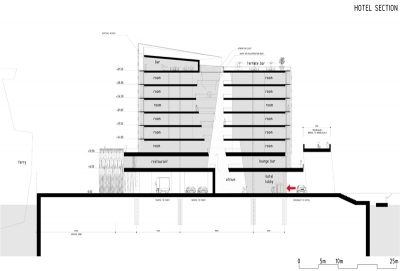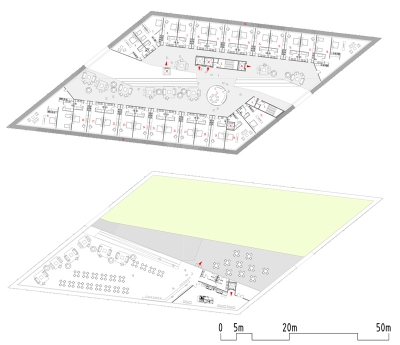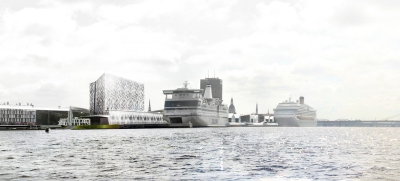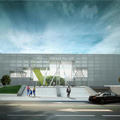
Project: Riga Passenger Terminal – Winning Proposal
Designed by No Rules Just Architecture NRJA
Project Team: Arch. Uldis Luksevics, Arch. Linda Leitane-Smidberga, Arch. assistant Martins Rusins, Arch. Ieva Lace, B. Arch Matiss Groskaufmanis
Total Area: 105 773 m2
Location: Riga, Latvia
Website: www.nrja.lv
Winning proposal for Riga Passenger Terminal project comes from No Rules Just Architecture – NRJA. Get familiar with the winning solution after the jump:
From the Architects:
The existing Riga Passenger Terminal is situated in an exclusive location – adjacent to the very centre of Riga. At the same time, the Terminal itself is an absolutely underdeveloped urban entity from 1970s with most of its surroundings sealed off from any kind of public use of the city.
With rapidly increasing visiting cruise ship volumes, the outdated infrastructure and absent connections to the very adjacent, yet unreachable city centre are undermining the vast potential of Riga Port Terminal to become an established, one-of-a-kind destination of cruise, as well as passenger transit maritime traffic.
The proposal for the Riga Passenger Port by NRJA envisions the development of the territory and port as a high quality urban environment which offers not only maritime transport, leisure, shopping and business experience but also public space connection to the city.
The proposal recognizes the unique backdrop of ??psala landscape of timber architecture as well as the UNESCO listed city centre on the other bank of the river Daugava that gives the new Port Terminal and its territory a unique set of qualities.
Regardless of the strict security measures needed for the part of the territory of the Port, the proposal prescribes a multitude of accessible public activities, commercial opportunities and recreational facilities.

The Promenade. The very backbone of the project is an elevated promenade which activates the existing, underdeveloped pedestrian zone along the river Daugava and connects public spaces, retail, hotel, terminal and other functions, all accessible from the same path. All across the given territory, it forms a straight axis, crossing the planned volumes and clearly separating the functions and program – premises for trade, offices, galleries and cafes from the Port Terminal and the Port Hotel volume itself. Beginning at the Vanšu Bridge and ending with the pedestrian bridge from the Port peninsulas northern end crossing towards Andrejsala, the Promenade also links the historic Old Riga with the upcoming mix-use development in Andrejsala, merging the currently unconnected embankments of Riga.


Synergy of the Passenger Terminal. All vehicle traffic within the territory of the port is organized on the ground level with an ambition to reduce the impact of traffic and use as much of the very limited amount of land as efficiently as possible and to open as much of the public space as possible. Above the ground, the proposal suggests connecting both major volumes of the competition territory – the Port Terminal and the Port Hotel, within a single floor high infrastructure slab, raised above the transport lanes and car parking zones. Connection of the hotel and Port Terminal volumes into a singular yet heterogeneous landmark entity conveys their significance as the main element in the whole port territory as well as generates programmatic and logistic connections between passenger flows and various functions. Being accessible from the ground floor, Passenger Terminal or the Promenade level above, the hotel is fully integrated into the Riga Port Terminal development. On one hand being connected to the Port Terminal and the public Promenade, the Port Hotel has its own autonomy – own traffic driveway, own entrances, own public square, own terraces etc.






The Port Hotel as a contextual landmark. The nine storey high four star hotel at the very end of the port peninsula is designed as a new vertical accent neutrally contributing to the skyline of Riga historic centre. The distinctive edge towards the dominant north-western winds defines the volume of the building while not covering views of the silhouette of the Old City. All the rooms of the hotel are distributed along the perimeter of facades allowing the unique views facing the vast perspective of Daugava on the north, an elevation of timber architecture of ??psala on the west, a silhouette of Old Riga on the south and the cosy yacht port and historically rich industrial and residential parts of the UNESCO listed Riga historic centre on the east.
Double facade system. The unique double facade system used for all the volumes within the primary competition territory allows the extents of individual volumes to be legible, while unifying the volumes into a singular architectural and programmatic composition. Conceptually, the elements forming the pattern of facades of the hotel and terminal buildings is generated by a synthesis of the surrounding context – water movement, reflection of sun in its waves, the sharp but delicate skyline of towers in the panorama of Old Riga. Technically, it ensures protection against excessive solar radiation, it allows a possibility of mechanical ventilation of premises without suffering from the impact of direct wind, it provides stack effect of air flows without mechanical aids and lastly but not least importantly, it mitigates the noise caused by ships and other traffic infrastructure nearby. At the level of Port Terminal, the double facade system, merging the port and hotel volumes, functions as a built-in horizontal gangway directing passenger flows along the facade of the building towards adjustable gangways which are connected to a ferry or ship.




Development of the extensive research territory. The territory of the competition can be developed in certain phases. In the extensive development area, commercial functions along with buildings necessary for ensuring the functioning of the Yacht are proposed. On the ground level, along the Eksporta Street, full single storey high slab volumes fill the given plot areas. The roof plane of the one-storey volume is planned equally high with the Promenade, which allows using it as public squares.



The configuration of the planned volumes between Eksporta Street and the Promenade is determined by necessity to provide maximum space in the new-constructed objects with daylight and view to water. Certain degree of contextuality and sensibility to the different aspects of the Riga historic centre is achieved through changing the roof profile of the proposed four storey buildings. The eastern ends of volumes facing the Eksporta Street acknowledge its urban morphology and responds to the silhouette of the orthogonal configuration of neighbouring facades accordingly. On the other end, the roofs of the volumes are pitched by responding to the panorama of historical timber low rise architecture of ??psala on the opposite, western bank of the river Daugava.






